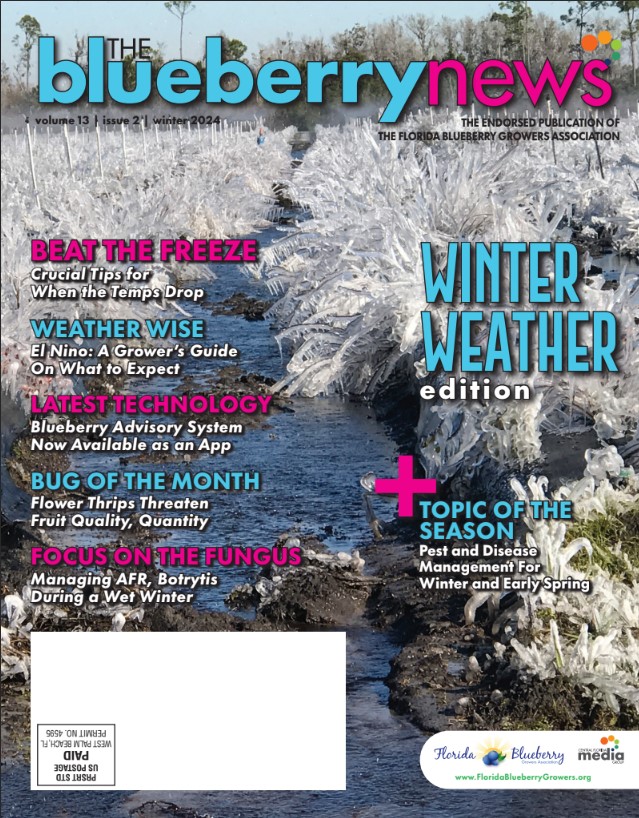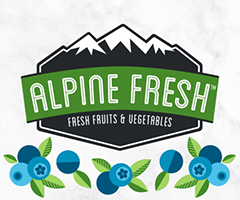Protect Your Crop When Temperatures Plummet
Untimely late winter and early spring freezes are one of the most problematic and yield-limiting phenomena that routinely impact blueberry production in Florida as well as other southeastern states. If you grow blueberries in Florida, it’s a pretty safe bet that you will need to protect your crop from freezing temperatures during the upcoming pre-bloom, bloom and/or post-bloom periods. I can only think of one year during the last 25 when we did not need to run overhead irrigation to freeze protect our blueberry research plots at the Plant Research and Education Unit in Citra. However, in a different year, we had to run overhead irrigation on nearly 20 separate nights. One truth about Florida’s winter weather is that it is consistently inconsistent. This article will review information that growers will likely want to consider when making decisions about freeze protection this coming year.
Freeze protection in Florida is most often accomplished with overhead irrigation. This method is usually effective, however, if the freeze event is accompanied by strong wind, and the air is dry (i.e., a low dew point), evaporative cooling from overhead irrigation may actually make plant tissue colder rather than protecting it from damaging temperatures.
To help assist in the preparation for the likelihood of a damaging freeze(s), we have included our updated annual Freeze Protection Checklist on the next page of this edition of The Blueberry News. Being well-prepared will help when making critical decisions based on weather forecasts and crop conditions. Having access to reliable weather forecast information is of utmost importance. Both free and membership-based online weather forecast services are available. Along with a reliable forecast, knowledge of crop stage is important as it has a significant effect on plant cold hardiness and the level of injury that might occur from a given freeze. Fully dormant buds in the deciduous production system are quite cold hardy. However, warm weather during winter can promote bud growth and expansion and reduce cold hardiness. Generally, the further developed flower buds are, the less cold hardy they become. With the evergreen production system that is often used in Central and South Florida, open flowers can be present as early as December. Furthermore, crop development may vary considerably among different cultivars planted together in the same field.
KEY FACTORS
Minimum temperature, wind speed, and dew point are three components of weather forecasts that are particularly important for making informed freeze protection decisions.
Temperatures can easily be monitored locally with well-positioned thermometers or weather stations. Experience during prior freezes may be useful to understand how temperatures might vary across production fields, the location of “cold pockets,” and other considerations. Thermometers should be placed in the coldest areas of a field as well as in typical areas of a field. Temperatures are likely to be more variable during a radiation freeze with little to no wind since this allows colder air to settle in low areas. Conversely, temperatures are relatively uniform during a freeze with significant wind due to mixing of air in and around the orchard. The forecasted wind speed is important for a number of reasons. A slight continuous breeze at night may add some warmth to the orchard by mixing warmer air aloft with the colder air in the orchard and preventing cold pockets from forming. However, a higher wind speed combined with critically low air temperatures can cause complications with overhead irrigation by increasing the amount of water needed to protect due to increased evaporative cooling.
Winds may also disrupt the uniformity of irrigation spray coverage resulting in a lack of protection in some areas of a field. Table 1 provides a guide for the application rate of water needed to protect at various temperature and wind speed combinations. Both wind speed and temperature, and their combined effect, have strong influences on the irrigation application rate needed during a given freeze event. You should be aware that this table does not account for exceptionally dry air, which would further increase the needed irrigation application rate. Generally dry air is more problematic than moist air during freeze protection.
The dew point temperature is a good indication of water vapor content of the air. The lower the dew point, the more water may be needed at a given temperature and wind speed due to increased evaporative cooling. Therefore dew point, along with minimum temperature and wind speed are important components of a weather forecast and are indicators of how much water may be needed during freeze protection. Please review the Winter Freeze Protection Checklist and refer to EDIS publication Protecting Blueberries from Freezes in Floridahttps://edis.ifas.ufl.edu/publication/HS216 for a more detailed discussion on blueberry plant hardiness and freeze protection in Florida.
Additional Sources of Information on Freeze Protection
Protecting blueberries from freezes in Florida. https://edis.ifas.ufl.edu/publication/HS216
Cold Protection toolkit. Florida Automated Weather Network (FAWN), Univ. of Florida Extension. https://fawn.ifas.ufl.edu/tools/coldp/
AgroClimate website. http://agroclimate.org/
University of Georgia Extension Circular 1128, Preparing Your Blueberry Freeze Protection System. https://secure.caes.uga.edu/extension/publications/files/pdf/C%201128_2.PDF
Figure 1. Clear ice is usually an indication that water was applied at a rate high enough for successful freeze protection. Photo credit, Jeff Williamson. Taken from Protecting Blueberries from Freezes in Florida, 2023. University of Florida, EDIS pub. HS216. https://edis.ifas.ufl.edu/publication/HS216
Table 1. Relationship between predicted minimum temperature and wind speed for irrigation application rates during freeze protection.
|
Minimum Temperature Expected |
Wind Speed in M.P.H. |
|||
|
0 to 1 |
2 to 4 |
5 to 8 |
10 to 12 |
|
|
Application Rate (inches/hour)1 |
||||
|
27 °F |
0.10 |
0.10 |
0.22 |
0.22 |
|
26 °F |
0.10 |
0.10 |
0.2 |
0.32 |
|
24 °F |
0.10 |
0.16 |
0.3 |
0.4 |
|
22 °F |
0.12 |
0.24 |
0.5 |
0.6 |
|
20 °F |
0.16 |
0.3 |
0.6 |
0.8 |
|
18 °F |
0.20 |
0.4 |
0.7 |
1.0 |
|
15 °F |
0.26 |
0.5 |
0.9 |
--- |
|
1 Dry air accompanied by wind will require higher application rates than indicated for a given temperature/wind speed combination. 2Application rates increased from original values due to the potential for evaporative cooling under windy conditions. Adapted from Gerber and Martsolf, Extension Circular 287, Florida Agricultural Extension Service. |
||||
CREDITS:
JEFF WILLIAMSON, UF/IFAS, Horticultural Sciences Department
& DOUG PHILLIPS, Blueberry Extension Coordinator, UF/IFAS





